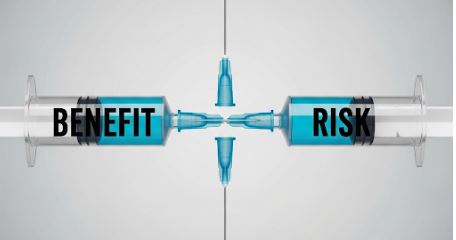Emerging trends in the peer-reviewed scientific literature show new evidence of unintended effects of two popular vaccines—the Human Papilloma Virus (HPV) and shingles vaccines. Surprising findings clearly indicate a relationship between these vaccines and various cancers, cardiovascular disease and dementia. This should raise concern for you and your family, and you should contact your physician as soon as possible—and make an appointment to get vaccinated.
While many in the upper echelons of public health rage on about claims of unintended negative side effects of vaccines, several recent reports refute popular online assertions of unanticipated risk. Quite to the opposite, several solid peer-reviewed reports reveal unexpected benefits of vaccination—results nobody anticipated yet are crystal clear as a vial of thimerosal.
A collection of recent scientific reports illustrates these effects. These unforeseen trends emerged from stepping back and taking a hard look at epidemiological data, unveiling reduced incidence of traditionally non-related pathologies in vaccinated populations. When large data sets from decades of tests and surveys are analyzed, vaccination for HPV appears to have protective effects against cancers beyond the human body’s nether regions, while the shingles vaccines protect against the onset of dementia, ophthalmic cancers, and also cardiovascular disease. The findings speak to an increasing role for viral infection as a cause of, or accelerant of, a broader set of debilitating human diseases than previously anticipated.
HPV Vaccine and Protection Beyond the Cervix
If there were a public health equivalent of a slam dunk or mic drop it would be the HPV vaccine. Those steeped in vaccine hesitancy or anti-vax denial errantly pooh-pooh the polio and measles vaccines, blaming their success on improved sanitation or antibiotic availability. However, the profound benefits of the relatively recently vintaged HPV vaccine in control of cervical cancer are impossible to ignore, except for those who choose to ignore them. But to add a layer of success on success, new analysis of global health trends suggests the HPV vaccine confers unexpected benefits against a range of seemingly unrelated cancers. While often vilified in anti-vaccination media as a culprit in human disorders, it appears that the opposite may be true; these new findings suggest unrealized protective roles for the HPV vaccine, and a wider contribution to public health.
The human papillomavirus is a sexually transmitted DNA virus. It is responsible for triggering approximately 5% of malignancies, including cervical, anal, vulvar/vaginal, and penile cancers. Emerging trends suggest a role in head and neck cancers and potential contributions to colorectal and non-melanoma skin cancers. However, the introduction of the HPV vaccine has dramatically decreased the incidence of HPV-related infections and its associated cancers. The vaccine targets the risky subtypes HPV 16 and 18, the viruses accounting for inducing 70% of cervical cancer cases.
And it works. The CDC indicates a substantial decrease in HPV-related cancers in females 15-34 years old, noting fewer incidences in high-grade cervical cell abnormalities. These findings are reflected in a number of large, long-term, well designed population studies (e.g. here and here) where researchers confirmed sustained immunity and a decrease in cervical neoplasias over many years.
A new study
The suppression of other sexually associated cancers has been noted, with a reduced incidence of oropharyngeal, anal, penile and vulvar cancers in HPV vaccinated populations, as expected. However, the punchline of an August 2025 study by Seebauer et al. indicates that the benefits of the HPV vaccine may extend well beyond the sexually transmitted cancers.
The study examined health records from the Global Collaborative Network on the TriNetX platform, a database covering 160 million patients from 143 health care organizations around the world. The data allow comparisons of any given variable, such as receiving the HPV vaccine, against all other patient records, including demographic data, lab results, vital signs, genomic data, cancer incidence, family history of malignancies, and many other factors. These data allow researchers to construct retrospective cohort analyses, in other words, define a vaccinated population, and assess correlating incidence of any health problems. Such exercises would identify potential negative or positive effects associated with the vaccine.
Seebauer et al. explored the incidence of malignancy in those receiving, or not receiving, the HPV vaccine, at 8 and 20 year time points after vaccine administration. Over 80,000 individuals were represented in the cohort receiving the vaccine 20-years prior. Variables such as alcohol and tobacco use, family history of cancers, and socioeconomic status were also incorporated to account for potentially confounding factors. Upon synthesis, several important findings emerged.
Not terribly surprising
The data reflect what we already know, which is always a good starting point. The results confirm the demonstrated effectiveness against cervical cancer, as well as their role against oropharyngeal squamous cell cancers. Statistically meaningful associations were seen between the HPV vaccine and decreased incidence of head and neck cancers, bolstering emerging research around these malignancies.
Equally of interest is what the data failed to show. Analysis curiously did not show a robust effect against rectal and anal cancers, which researchers suggest is due to the long latency period of the infection or narrower protective effect of the vaccine against these cancers.
An unexpected surprise
But the big surprise was an apparent protective effect against some blood, lung and nervous system cancers. Those in the 20-year post-vaccination cohort showed lower incidence of leukemias, lung cancer, and cancers of the cranial nerves and spinal cord, as well as possible association with cancers of the eye. These findings support the hypothesis that protection against specific viruses has cross-protective effects against a series of seemingly unrelated cancers.
The authors note that it is a retrospective study and that the associations unveiled could be due to other confounding factors, such as misdiagnosis or errors in record keeping in the dataset, as well as factors not included in the database. Males were also not included in the early phases of HPV vaccination in many countries, which also may affect the results.
But even with those limitations the conclusion is clear—HPV vaccines show strong benefit in the prevention of cervical and anogenital cancers. But as important, the inferred protective effects against non-cervical malignancies indicate that the vaccine should be used more widely in gender-neutral vaccination campaigns.
Shingles Vaccines Confer Protection from Dementia Onset
Shingles is a painful, blistery rash caused by the herpes zoster virus, the same virus that causes chickenpox. The virus remains dormant in the central nervous system for years after the initial chickenpox flare up but may re-activate in older age as the immune system wanes, traveling along nerves to the skin to where the painful rash emerges.
But there are vaccination strategies to limit the incidence of shingles. The Zostavax vaccine was introduced in 2006, a live, attenuated virus that would induce immune response against the virus. A more recent recombinant version has also been developed. But does the shingles vaccine have any unintended side effects? It certainly appears to—it decreases the risk of dementia, as revealed by a brilliant experiment.
Vaxed vs unvaxed studies
In Wales, a shingles vaccination program began September 1, 2013, and anyone who was 79 on that date was eligible for the vaccine. Those 80 and over were not eligible due to a limited supply of the vaccine. Using public databases, researchers could track the vaccinated cohort (born the first week of September 1933) and compare them to the unvaccinated cohort (born the last week of August 1933). These two calendar-based groupings allowed diffusion of all other confounding variables, creating two populations that were essentially random, different only in that one was about a week older– and not vaccinated.
The group that received the vaccine exhibited a reduced incidence of shingles, as expected. Seven years later, the vaccinated group was 20% less likely to develop signs of dementia than the unvaccinated cohort. Similar results were observed in Australia, New Zealand and Canada, three other countries with the same record keeping practices around the introduction of the vaccine. These findings set the stage for larger clinical trials, as they certainly suggest that the shingles vaccination has a preventative effect against dementia.
Cardiovascular Protection from Herpes Zoster Vaccine
Another recently published report examined populations over 50 years old that received two doses of recombinant zoster vaccine (~102k) to those that did not receive the vaccine (~411k). The matched-cohort study then examined in the incidence of herpes zoster ophthalmicus (HZO; a herpes infection of the eye that occurs in 10% of shingles cases), heart attack and stroke.
The vaccinated group was 72% less likely to suffer HZO, with a 28% lower likelihood of heart attack and a decreased risk of stroke by 42%. The strengths of the study include a large, diverse population and favorable accounting of confounding variables. The study population will continue to be monitored to test for continuation of these trends over time.
Another recent study examined the effect of zoster vaccination in over 1.2 million South Koreans over 50. Examination of health records revealed that participants that received the vaccine had a 23% lower risk of a cardiovascular event, including stroke, heart attack or death from heart disease. The protective effect was strongest a few years after vaccination, consistent with the fact that live vaccine effectiveness wanes over time.
In call cases the mechanism of protection is unclear, but heart attacks and strokes are more frequent during an active herpes zoster infection, so avoiding the infection should reduce the risk. Neuroinflammation is a hallmark of zoster infections and may be a contributing factor to dementia. It also is important to remember that these are causal associations, the latter in a narrow demographic, so additional studies will need to be performed. However, it is clear that there is benefit from vaccinations against zoster, even without considering the protective effects against heart attacks, stroke and dementia.
Might This New Evidence Break Hesitancy?
These emerging trends in unintended vaccination benefits underscore their importance of in public health, now in mitigating tangential disorders. But more importantly, these findings present bona fide evidence that advocates may deploy in persuasive science communication campaigns. Antiquated references to infectious diseases like polio and diphtheria don’t move the needle, or the syringe it is attached to. The historic devastation of forgotten disease does not resonate against the glitz of targeted anti-vaccination rhetoric.
But from a communication standpoint vaccine hesitancy has always been fueled by emotional campaigns, and then opposed with evidence, logic and reason. Unfortunately, in the battle of the heart against the head, the heart always wins. This is especially true when children are involved, and an affluent population protected by herd immunity, unthreatened by infectious disease, can afford precautionary decisions.
But in an aging population the specter of cancers and dementia looms real, and just about every family will experience some version of these long term diseases or disorders. The mounting evidence of vaccine cross-protection finally may offer physicians and vaccine advocates an opportunity to wield relatable, emotional rhetoric that may cause some of the reachable hesitant to begin to reconsider their positions.
It is also a reminder that HPV and shingles vaccines should be a broader part of public health protection, more than the young women and elderly folks that are typically associated with these preventative measures. It also reminds us that viral infections are important to control, as their long term manifestations may be more deleterious than we previously understood.





